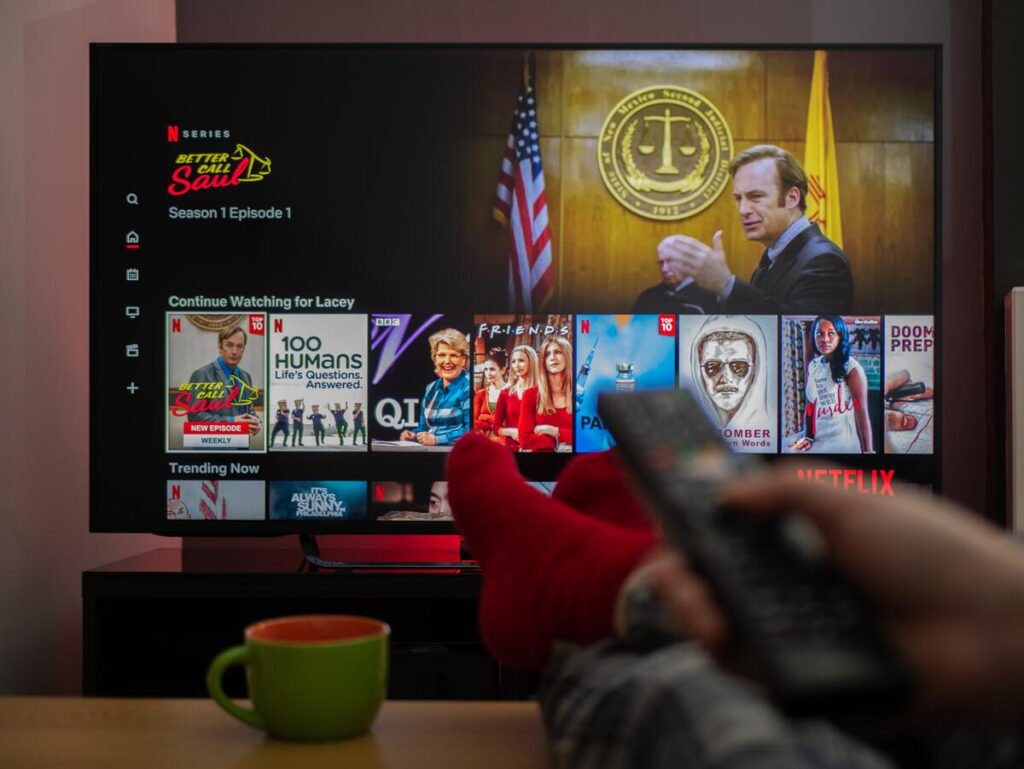How Much Data Does A Smart TV Use? (With Examples)
Disclosure: Tech Parasol is supported by its readers. When you purchase through links on our site, we may earn an affiliate commission. Thank you.
- A Smart TV can use between 225 MB/hour and 15.98 GB/hour streaming video depending on the resolution.
- 4K streaming uses significantly more data than full-HD content.
- The resolution of the content being streamed is the main factor in how much data is consumed.
Knowing how much data your Smart TV uses can prevent you from going over your home Internet’s data cap.
So let’s look at some numbers, which apps use the most and how to reduce the amount of data you’re using.
Let’s get started.
Here’s how much data a Smart TV uses:
A Smart TV playing YouTube videos uses between 225 MB/hour at a resolution of 426×240. At a 4K resolution and 60 fps this increases to 15.98 GB/hour. Video content uses much more data than streaming audio. But the specific amount of data used varies depending on the resolution and frame rate.

How much data does a smart TV use per hour?
A Sony Bravia Smart TV uses 1.73 GB of data whilst streaming a YouTube video for one hour.
I was able to measure this by connecting my TV to a mobile hotspot.
Then I used a hotspot monitoring app called NeoData to record the usage.
Generally though, the amount of data a Smart TV uses per hour depends on the following:
- Type of content (audio or video)
- Content resolution
- Frame rate
To give you some more numbers, consider the following:
Netflix
Netflix varies from 0.3 GB/hour to 7 GB/hour. At the lower end of this range, this is what Netflix calls “basic video quality”.
At the top end, Netflix calls this “best video quality” and is up to 4K in resolution.
YouTube
YouTube uses an average of 225 MB/hour at a resolution of 426×240 and 15.98 GB/hour at a 4K resolution at 60 fps.
Music Streaming
Music streaming varies from 43.2 MB/hour up to 115.2MB per hour depending on the bitrate.
At the lower end, the bit rate is typically 96kbps and on the higher end, the bit rate is typically 320kbps.
So it’s clear that video uses a lot more data than audio content.
If you stream movies in 4K on Netflix, that’s going to eat into your monthly allowance quicker than a full-HD movie.
Increasing the frame rate will also use more data. But it will give you a smoother viewing experience.
How much data is needed to stream movies?
Assuming you watch three movies per week and each movie lasts for 2 hours on average, you’ll use about 78 GB of data per month.
This is based on data from Netflix where they say a high quality (full-HD) stream will use about 3GB of data per hour.
Of course this doesn’t take into account other devices such as laptops, tablets and phones.
So if this mirrors your typical data usage, then you may want to consider getting an unlimited data plan.
Does online gaming use more data than streaming movies?
Online gaming typically uses less data than streaming movies.
Games such as Team Fortress 2, League of Legends and Rainbow Six Siege use between 50 MB and 100 MB per hour.
Contrast that with a full-HD Netflix movie at 3 GB per hour and the difference is huge.
Granted some games have massive downloads like 100 GB.
But if that game lasts for 100 hours, that’s a lot less data than 100 hours of full-HD Netflix movies!
Do 4K movies use more data than full-HD?
4K movies use significantly more data than those in full-HD.
According to Netflix, 4K movies use 7 GB per hour whilst full-HD movies use 3 GB per hour.
The reason for this is that a 4K frame contains four times the information of full-HD.
The raw file size of a 4K movie is also four times the size of a full-HD file.
Do larger smart TVs use more data than smaller TVs?
Screen size does not determine how much data a TV uses.
A cellphone streaming 4K will use more data per hour than a 65 inch TV streaming a movie in full-HD.
But a TV will negotiate higher resolution content from the server than a smartphone.
This is because TVs generally have a higher resolution screen.
TVs are usually connected to a home WiFi network or via an ethernet cable.
This gives them more bandwidth than say a cell phone connected to a 3G network.
In this case, the server will likely reduce the video quality on the cellphone.
Which apps use the most data on Smart TV?
Smart TV Apps such as YouTube, Amazon Prime, Netflix, BBC iPlayer and other streaming services use the most data.
Does a Smart TV use data in stand-by mode?
Smart TVs can use data in stand-by mode when they are downloading updates or sending usage data and statistics.
A TV that is in standby-mode isn’t really off. It’s just the display that’s off but the TV will still continue to be active.
How to monitor data usage on your Smart TV
There are a few ways to monitor data usage on your Smart TV:
- Using your router
- Installing an app on the TV
- Use a streaming device such as a Firestick
Router
Your router should provide you with accurate information on your Internet usage.
Some routers provide data monitoring tools, others don’t.
Routers provided by your ISP often have only basic features and functionality.
My router, which was provided by my ISP, only shows data usage since the last hub restart.
It doesn’t provide per device usage either, so it’s impossible to know which device is using the most data.
Installing an app
If your TV allows it, you could install an app which allows you to monitor data usage.
This is a lot easier if you have an Android TV which will allow you to install third-party apps.
Use a streaming device
Rather than use the Smart TV directly, you could use a streaming device such as an Amazon Firestick.
They often come with their own in-built data monitoring tools
To access these tools on a Firestick, go to Settings -> Preferences -> Data Monitoring.
When enabled, you can set the video quality, data alerts and get monthly reports on the apps that use the most data.
How to reduce data usage on Smart TV
Here are some of the things you can do to reduce data usage on your Smart TV:
- Use standard quality (SD) video whilst streaming. Full-HD (1080p) or ultra-high quality (4K) will eat up a lot of data.
You can configure the playback resolution in apps such as YouTube and Netflix. You can also limit the output resolution of your streaming device. - Use lower frame rates (if possible).
- Keep the TV firmware up to date. Out of date firmware can cause a TV to use data even when not in use.
- Turn off autoplay to prevent the app showing episodes and trailers you don’t want to watch. Amazon Prime I’m looking at you!
- Power off the TV when not in use.
Sources
How to control how much data Netflix uses
Choose live encoder settings, bitrates, and resolutions – YouTube Help
How much mobile data does streaming media use?
How Much Data Does Online Gaming Use?
Does Online Gaming Really Use a Ton of Bandwidth?

Robert Anderson
Robert Anderson, the founder of Tech Parasol, had a keen interest in tech from a very young age. He studied Electronic Engineering at University and then went on to become a Software Developer. He launched Tech Parasol in 2021 to share his knowledge with the aim of making tech easier to understand for everyone.

